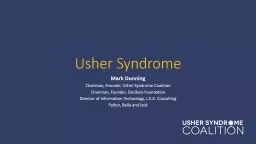

Chairman Founder Usher Syndrome Coalition Chairman Founder Decibels Foundation Director of Information Technology LEK Consulting Father Bella and Jack Bellas Story 17 Years Old Born Deaf ID: 1000056
Download Presentation The PPT/PDF document "Usher Syndrome Mark Dunning" is the property of its rightful owner. Permission is granted to download and print the materials on this web site for personal, non-commercial use only, and to display it on your personal computer provided you do not modify the materials and that you retain all copyright notices contained in the materials. By downloading content from our website, you accept the terms of this agreement.
1. Usher SyndromeMark DunningChairman, Founder, Usher Syndrome CoalitionChairman, Founder, Decibels FoundationDirector of Information Technology, L.E.K. ConsultingFather, Bella and Jack
2. Bella’s Story17 Years OldBorn DeafCochlear implant at age 2Signed until age 3Usher diagnosis at age 8 Love horsesEnjoys musicExcellent photographer
3. What is Usher syndrome?Most common cause of combined deafness and blindness.Congenital hearing loss and progressive vision loss from Retinitis Pigmentosa. Some forms have vestibular loss.First described in 1858 by Albrecht von Graefe, a German ophthalmologist.Named for Charles Usher, a British ophthalmologist who did first definitive study in 1914.
4. Kimberling’s DiseaseBill Kimberling first researcher dedicated to Usher syndrome researchWilliam J. Kimberling Usher Research Laboratory at University of Iowa Dedicated June 2015
5. Frequency of UsherOrphan diseaseHistorical: 3% of patients with congenital bi-lateral sensorineural hearing lossActual: 8-12% of patients with congenital bi-lateral sensorineural hearing loss30,000 to 50,000 people in the United States.400,000 world-wide
6. Research ContinuumBasicTranslationalTrialsTreatmentsIIIIIIIVThe line between basic and translational research is blurryResearch and trials take yearsFour phasesPhase I: Safety in small groupPhase II: Efficacy in small groupPhase III: Efficacy in large groupPhase IV: Monitor long term clinical usage for side effectsOnly 1 in 12 human trials results in a clinical treatmentNeed lots of clinical trial candidates!$$$$$$$
7. State of Usher Syndrome ResearchBasicTranslationalTrialsTreatmentsNotesStem Cells (Vision)Stargardts and AMDStem Cells (Hearing)Gene TherapiesUsher 1b, RPE65Drug TherapiesUsher?Ocular ImplantsUsher?Vestibular ImplantsUsher?OptogeneticsUsher?Identify potential candidates
8. Families are Critical to Research SuccessSource of natural history informationSource of genetic informationPool of candidates for clinical trialsSource of funding and advocacySource of awareness which impacts funding and motivates researchersFamilies are the market that entices investment
9. We Are Not in Touch with Enough Usher FamiliesResearch community is in contact with less than 1% of 400,000+ people world wide with Usher SyndromeInternational Symposium on Usher SyndromeHarvard Medical School, July 2014Greatest barrier to treatment development: We are not in touch with enough familiesClinical trials will be suspended, abandoned, or simply not begun without enough candidates.
10. Problematic Communication of DiagnosisPeople with Usher are deaf and go blind. There are no treatments for Usher syndrome.There is nothing you can do to slow the progression.It is rare so you probably won’t meet other families with Usher syndrome.Alienates peopleLose hope and lose contact right from the start
11. It doesn’t have to be this way! Community support is critical.Gone is the expected life, facing the unknownOn-going grief – disease is progressiveTransportation is difficult - become more isolated, withdrawn and grief-strickenFewer people work as their vision deteriorates82% unemployment among deafblind adultsFears, anxieties, depression, suicidal ideationMen with Usher are more than 6 times as likely to commit suicide
12. Life in the Usher communityDiagnosis as infantsWe don’t know the normal progression of vision loss in Usher syndromeDeaf is not deafCochlear implants/hearing aidsBlind is not blind50% of people with Usher can still read a newspaper at age 50Highly unlikely child born today will fully lose visionUsher syndrome isn’t a death sentence.People with Usher have athletic success, go to college, get married, have kids, and have successful careers.
13. Usher Syndrome Coalition MissionTo raise awareness and accelerate research for the most common genetic cause of combined deafness and blindness. The Coalition also provides information and support to individuals and families affected by Usher syndromeGoal: Identify and genetically test every person in the world with Usher Syndrome
14. USHTrust FactsLargest Usher syndrome registry in the worldMore than 1500 families52 countriesDeveloped by Mani IyerHas UsherVolunteered his timeCreated character by character
15. USHTrustAvailable onlinewww.usher-registry.orgUsher Syndrome Coalition web siteVoluntaryOpt out at any timeSimpleRequires only name and e-mailAccessibleWorks with JAWS and other readersAvailable in English, Spanish, Hebrew, and DutchIn development: German, Portuguese, French, SwedishSecure and confidential: HIPAA compliantHealth Insurance Portability and Accountability Act (HIPAA)
16. Unraveling USHGenetic testing program jointly developed with William J. Kimberling Usher Laboratory at University of IowaProvide genetic testing to all families with Usher syndromeFree testing available to those who qualifyMore and more countries are providing genetic testing
17. Hope ContinuumBasic KnowledgeFollowing ResearchConnectionsParticipationIIIIIIFamilies need time to deal with emotion of diagnosis Need to understand disease before following researchEventually they want to talk with others about UsherPhase I: Talk to experts Phase II: Meet others of similar age, Usher typePhase III: Participate in larger Usher communityFull participation in the community takes time
18. Hope ContinuumBasic KnowledgeFollowing ResearchConnectionsParticipationIIIIIIWeb siteUsher-syndrome.orgDozens of presentations from leading researchersBlog with family experiences and success storiesInformation on diseaseInitial sense of hopeUSHTalks – October 2016Accessible, controllable, captioned videos with latest Usher research and community newsQuarterly newsletters
19. Hope ContinuumBasic KnowledgeFollowing ResearchConnectionsParticipationIIIIIIUSH Bluebook family networkConnect 500 families/30 countriesUSH Bluebook online forumGoogle forum for USH Bluebook families to share adviceSocial MediaFacebook: 5 starsTwitter: @UsherCoalition
20. Hope ContinuumBasic KnowledgeFollowing ResearchConnectionsParticipationIIIIIIAnnual Family ConferencesOne dayFamilies and researchersChild programsAccessibleOpportunity for all in the Usher syndrome community to meetLong breaks for networkingChicago, July 2017
21. Hope ContinuumBasic KnowledgeFollowing ResearchConnectionsParticipationIIIIIIInternational SymposiumsJuly 2014, Harvard Medical SchoolNext symposium in EuropeTwo day science conference combined with one day family conferenceCollaboration between researchersOpportunity to connect with familiesJuly 2018, Mainz, Germany
22. ParticipationBasic KnowledgeFollowing ResearchConnectionsParticipationIIIIIIJoin the USHTrustMentors in International Usher Syndrome Family NetworkVolunteeringFundraisingAdvocacyParticipating in psychosocial studiesCandidate for clinical trials
23. Thank YouRegistry: www.usher-registry.orgWeb site: www.usher-syndrome.orgMark Dunning: m.dunning@lek.comKrista Vasi: k.vasi@usher-syndrome.org